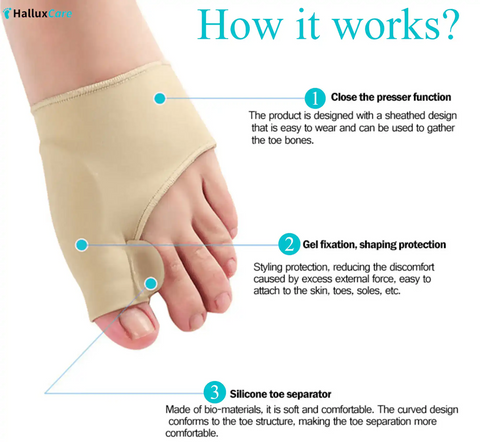Bunions and Ankle Pain: Is There a Connection?
Last Updated: June 2025 | Reviewed by: Jessica Martin, DPM – Board-Certified Podiatrist
If you’ve been dealing with persistent heel or ankle pain alongside large bunions, you’re not alone. Many people silently suffer, unsure whether their bunions are the root cause of other foot and joint issues. One Reddit user recently described difficulty walking due to ankle and heel pain—even while using orthotics—highlighting a common but often misunderstood question: Can bunions be responsible for pain elsewhere in the lower body?
This article explores the medical connection between bunions and ankle pain, the underlying biomechanics, and real-world strategies for relief. We also provide helpful tips, expert insights, and answers to frequently asked questions to support your foot health journey.
4.9 ⭐⭐⭐⭐⭐ ( 1843 reviews )
Understanding the Link Between Bunions, Ankle Pain, and Tendonitis
Bunions—medically known as hallux valgus—are more than just cosmetic concerns. They reflect a misalignment of the first metatarsophalangeal (MTP) joint, often caused by genetic predisposition, poor footwear, or biomechanical abnormalities. According to the American Academy of Orthopaedic Surgeons (AAOS), the misalignment can affect how weight and pressure are distributed across the foot, resulting in a cascade of compensatory movements throughout the lower body.
How Bunions Can Create a Chain Reaction:
- Altered Gait: Bunions shift your weight distribution, which can change your walking mechanics and place strain on the ankle, knees, and hips (source: American Podiatric Medical Association).
- Overcompensation: To avoid bunion pain, people often unconsciously walk differently. This can overwork muscles and tendons in the foot and ankle, leading to inflammation or tendonitis.
- Reduced Arch Support: Bunions can lead to pronation (foot rolling inward), weakening arch support and destabilizing the ankle.
- Stress on the Achilles Tendon: A misaligned foot alters how the heel strikes the ground, potentially inflaming the Achilles tendon and causing heel pain or plantar fasciitis (source: Mayo Clinic).
Signs Your Bunion May Be Affecting Other Areas
- Chronic ankle or heel pain, especially during or after walking
- Swelling or stiffness in the ankle or arch of the foot
- Foot fatigue or imbalance when standing for long periods
- Tightness or burning sensations in the Achilles tendon or arch
Why Orthotics Might Not Be Enough
While orthotics are a foundational tool in foot care, they may not fully resolve problems caused by bunion-related misalignment. In some cases, poorly fitted inserts can aggravate symptoms or fail to provide adequate support for the altered foot structure.
Tips for Maximizing Orthotic Effectiveness:
- Seek evaluation from a podiatrist or orthopedic specialist for custom-fitted orthotics.
- Use orthotics in shoes with a wide toe box and firm arch support to prevent further deformity.
- Alternate orthotics based on activity level—daily walking vs. sports or high-impact movement.
- Pair orthotics with medical-grade bunion sleeves to encourage joint realignment and reduce friction.
Relief and Prevention: What You Can Do
Addressing bunions and their ripple effects doesn’t always require surgery. Evidence-based conservative treatments can significantly reduce pain and improve function.
Effective At-Home Strategies:
- Toe Alignment Devices: Medical-grade bunion sleeves, like the ones below, help reposition the joint and reduce pressure on surrounding tissues.
- Stretching & Strengthening Exercises: Perform toe flexor stretches, heel raises, and resistance band exercises to reinforce foot and ankle stability (source: Journal of Foot and Ankle Research).
- Anti-inflammatory Support: Apply natural oils like castor oil, known for anti-inflammatory properties, to reduce swelling and discomfort.
- Smart Footwear: Choose shoes with a wide toe box, minimal heel elevation, and firm arch support to prevent progression of bunions and reduce ankle strain.
If you're looking for relief from bunion pain, consider using the Orthopedic Bunion Pain Relief & Correction Sleeve , which provides support and helps to alleviate discomfort.
For additional protection, the Tailor's Bunion Bunionette Pain Relief Protection Sleeves are designed to offer comfort and protection for bunionette pain.
To nourish and soothe the skin around bunions, as well as to promote healthy hair, consider the Jamaica Black Castor Oil Soothing Oil . Known for its moisturizing and anti-inflammatory properties, it helps alleviate discomfort around bunions and supports hair growth and scalp health.
Key Takeaways
- Bunions can cause or aggravate ankle, heel, and tendon pain due to structural misalignment.
- Gait changes from bunions may lead to overuse injuries like tendonitis and plantar fasciitis.
- Orthotics are helpful but must be properly fitted and combined with supportive footwear and alignment devices.
- Non-surgical treatments like bunion sleeves, targeted exercises, and anti-inflammatory care can improve symptoms.
FAQs
Do bunions cause ankle pain?
Yes. Bunions can shift your walking mechanics, placing stress on the ankle joint and surrounding tendons, which can lead to pain and instability.
Can I treat bunion-related ankle pain without surgery?
In many cases, yes. Conservative treatments like bunion correction sleeves, orthotics, and strengthening exercises can provide significant relief. Always consult a podiatrist to explore your options.
Are bunion sleeves effective?
Medical-grade bunion sleeves are designed to gently realign the big toe, relieve pressure, and support the joint. They can be a helpful non-invasive option when used consistently.
What type of shoes should I wear if I have bunions and ankle pain?
Look for shoes with a wide toe box, strong arch support, and cushioning in the heel. Avoid high heels or narrow shoes that compress the toes.
How do I know if my orthotics are helping or hurting?
If you experience increased pain, numbness, or discomfort after using orthotics, they may not be properly fitted. Consult a podiatrist for a gait analysis and orthotic reassessment.
Final Thoughts
Disclaimer: This article is for informational purposes only and does not substitute professional medical advice, diagnosis, or treatment. Always consult a qualified healthcare provider with any questions about your condition.
Disclosure: We may earn a small commission from links to recommended products. This helps support our content at no extra cost to you.




